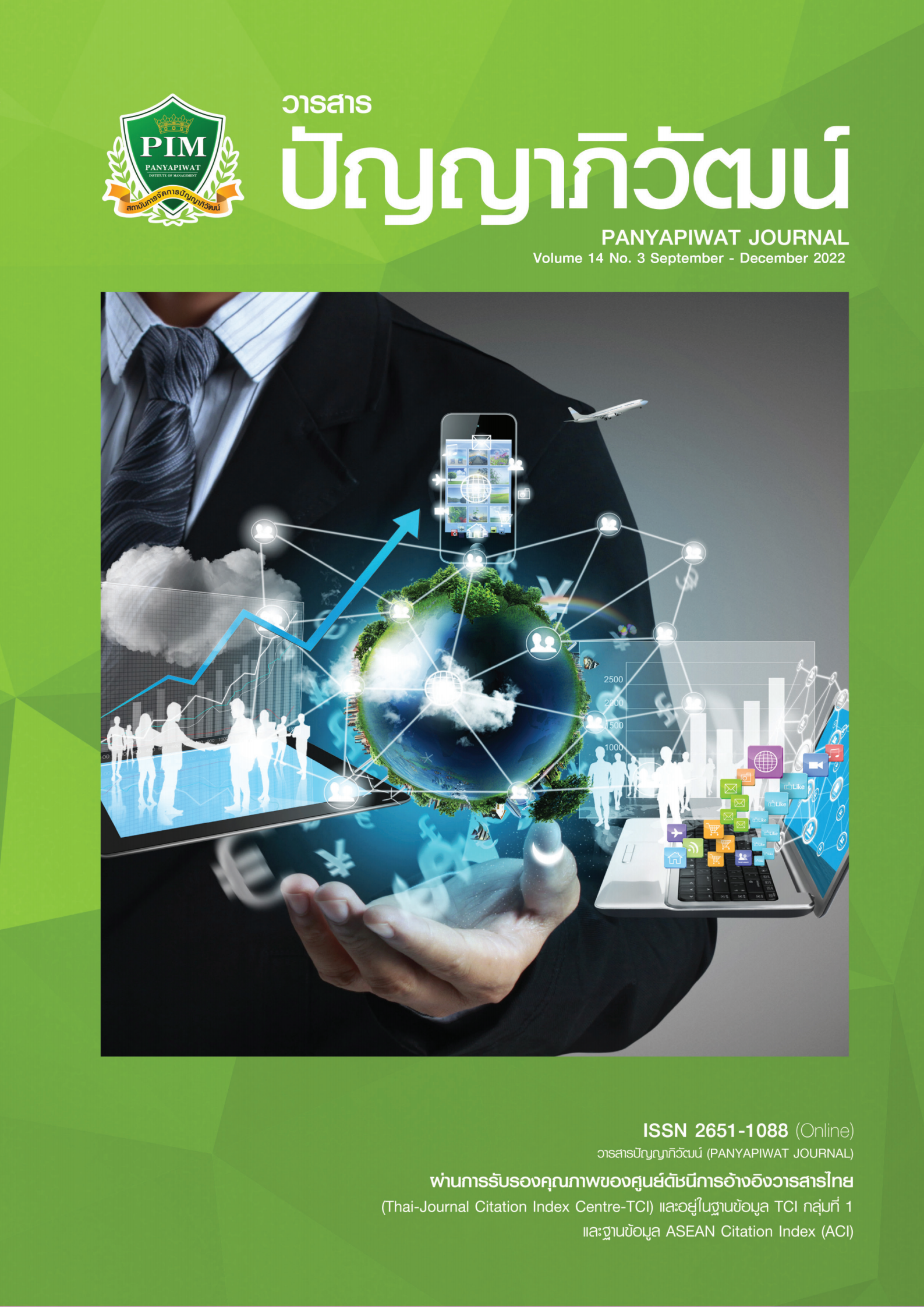การวิเคราะห์พฤติกรรมที่ไม่เหมาะสมจากการรับรู้ของเจ้าบ้านชาวไทยและนักท่องเที่ยวชาวจีน
Main Article Content
บทคัดย่อ
การวิจัยเรื่องนี้มีจุดมุ่งหมายที่จะวิเคราะห์การรับรู้เกี่ยวกับพฤติกรรมที่ไม่เหมาะสมของนักท่องเที่ยวในแง่ของความบ่อยของการเกิดพฤติกรรมและทัศนคติต่อพฤติกรรมเหล่านั้น ในแง่ของความรู้สึกรำาคาญต่อพฤติกรรมเหล่านั้น จากมุมมองของเจ้าบ้านชาวไทยและนักท่องเที่ยวชาวจีน ประชากรที่ศึกษา ได้แก่ เจ้าบ้านชาวไทยซึ่งหมายถึงผู้ปฏิบัติงานในอุตสาหกรรมท่องเที่ยวไทย จำนวน 401 คน และนักท่องเที่ยวชาวจีนที่กำลังท่องเที่ยวอยู่ในประเทศไทยจำนวน 498 คน กลุ่มตัวอย่างเจ้าบ้านชาวไทยใช้การสุ่มตัวอย่างแบบเจาะจงสำหรับกลุ่มตัวอย่างนักท่องเที่ยวชาวจีนใช้วิธีการสุ่มแบบตามสะดวก เครื่องมือที่ใช้คือ แบบสอบถามภาษาไทยและภาษาจีน การจำาแนกพฤติกรรมที่ไม่เหมาะสมใช้วิธีการวิเคราะห์ปัจจัย ผลการวิจัยพบว่า พฤติกรรมที่ไม่เหมาะสมต่าง ๆ สามารถจัดเป็นปัจจัยหรือประเภทได้ 6 ประเภท ได้แก่ 1) พฤติกรรมที่มีผลกระทบโดยตรงต่อผู้อื่น 2) พฤติกรรมส่วนบุคคลที่ส่งผลกระทบต่อสุขภาพของผู้อื่นและสิ่งแวดล้อม 3) นิสัยการปฏิบัติตัวตามความเคยชินทั้ง ๆ ที่อยู่ในสิ่งแวดล้อมในต่างประเทศและละเมิดบรรทัดฐานทางสังคมที่เป็นสากล 4) พฤติกรรมที่หมิ่นเหม่ต่อการกระทำาที่ผิดกฎหมาย 5) การปล่อยตัวตามสบายโดยไม่สนใจว่าผู้อื่นจะคิดอย่างไร 6) การปฏิบัติตัวที่เป็นปกติวิสัยของนักท่องเที่ยวทั่วไป การนำเสนอแผนภูมิแสดงระดับความบ่อยของการรับรู้และระดับความรำคาญต่อพฤติกรรมทั้ง 6 ประเภท แสดงให้เห็นว่าพฤติกรรมที่เจ้าบ้านและนักท่องเที่ยวพบเห็นบ่อยและรู้สึกเดือดร้อนรำคาญคือ พฤติกรรมที่มีผลกระทบโดยตรงต่อผู้อื่น จึงเป็นพฤติกรรมที่ผู้ที่เกี่ยวข้องควรให้ความสนใจเฉพาะในประเด็นนี้เป็นพิเศษ
Article Details

อนุญาตภายใต้เงื่อนไข Creative Commons Attribution-NonCommercial-NoDerivatives 4.0 International License.
“ข้าพเจ้าและผู้เขียนร่วม (ถ้ามี) ขอรับรองว่า บทความที่เสนอมานี้ยังไม่เคยได้รับการตีพิมพ์และไม่ได้อยู่ระหว่างกระบวนการพิจารณาลงตีพิมพ์ในวารสารหรือแหล่งเผยแพร่อื่นใด ข้าพเจ้าและผู้เขียนร่วมยอมรับหลักเกณฑ์การพิจารณาต้นฉบับ ทั้งยินยอมให้กองบรรณาธิการมีสิทธิ์พิจารณาและตรวจแก้ต้นฉบับได้ตามที่เห็นสมควร พร้อมนี้ขอมอบลิขสิทธิ์บทความที่ได้รับการตีพิมพ์ให้แก่สถาบันการจัดการปัญญาภิวัฒน์หากมีการฟ้องร้องเรื่องการละเมิดลิขสิทธิ์เกี่ยวกับภาพ กราฟ ข้อความส่วนใดส่วนหนึ่งและ/หรือข้อคิดเห็นที่ปรากฏในบทความข้าพเจ้าและผู้เขียนร่วมยินยอมรับผิดชอบแต่เพียงฝ่ายเดียว”
เอกสารอ้างอิง
Banterng,T. (2017). China’s image repair:The case of Chinese tourists on social media in Thailand. Global Media Journal, 15(29), 1-9.
Berry, L. L., & Seiders, K. (2008). Serving unfair customers. Business Horizons, 51, 29-37.
Bowen, D. E. (1986). Managing customers as human resource in service organizations. Human Resource Management, 25(3), 371-383.
Chen, N., Hsu, C. H., & Li, X. R. (2018). Feeling superior or deprived? Attitudes and underlying mentalities of residents towards Mainland Chinese tourists. Tourism Management, 66, 94-107.
China National Tourism Administration. (2013). Guide to civilized tourism. https://docplayer.net/23935020-Guide-to-civilised-tourism.html
Doxey, G. V. (1975). A causation theory of visitor-resident irritants, methodology, and research inferences. In Sixth Annual Conference Proceedings of the Travel Research Association, San Diego (pp. 195-198). Travel and Tourism Research Association.
Editor ChiangRai News. (2015). Chiang Rai’s white temple refuses Chinese tourists for bad toilet manners. https://www.chiangraitimes.com/chiang-rais-white-temple-refuses-chinesetourists-for-bad-toilet-manners.html
Fullerton,R. A., & Punj, G. (1993). Choosingto misbehave: A structural model of aberrant consumer behavior. InL. McAlister, & M. L.Rothschild (Eds.), NA-Advances in Consumer Research Volume 20 (pp. 570-574). Association for Consumer Research.
Fullerton,R. A., & Punj, G. (1997). What is consumer misbehavior? Advances in Consumer Research, 24(1), 336-339.
Grybś-Kabocik, M., & Marie, A. (2016). Consumer misbehavior in tourism market. In CBU International Conference on Innovations in Science and Education (pp. 121-125). CBUNI. http://dx.doi.org/10.12955/cbup.v4.751
Harris, L. C., & Daunt, K. L. (2011). Deviant customer behaviour: A study of techniques of neutralization. Journal of Marketing Management, 27(7-8), 834-853.
Harris, L. C., & Daunt, K. L. (2013). Managing customer misbehavior: Challenges and strategies. Journal of Services Marketing, 27(4), 281-293.
Hsu, C. H. C., & Song, H. (2012). Projected images of major Chinese outbound destinations. Asia Pacific Journal of Tourism Research, 17(5), 577-593. https://doi.org/10.1080/10941665.2011.630674
Lai, M.L. (2016). The impact of Mainland Chinese tourists’ misbehaviour on Thailand’s tourism. https://www.tci-thaijo.org/index.php/jitt/article/download/65739/53742
Li, A. (2013). Why are Chinese tourists so rude? A few insights. https://www.scmp.com/news/china/article/1251239/why-are-chinese-tourists-so-rude
Li, M., Zhang, H., Mao,Y., & Deng, C. (2011). Segmenting Chinese outbound tourists by perceived constraints. Journal of Travel and Tourism Marketing, 28(6), 629-643.
Loi, K. I., & Pearce, P. (2015). Annoying tourist behaviors: Perspectives of hosts and tourists in Macao. In H. Kam, & X. Li (Eds.), Chinese consumers in a new era: Their travel behaviors and psychology (pp. 395-416). Routledge.
Ma, Y., Ooi, C. S., & Hardy, A. (2018). Chinese traveling overseas and their anxieties. In Asian Cultures and Contemporary Tourism (pp. 201-220). Springer Nature Singapore Pte Ltd. https://www.researchgate.net/publication/323407792_Chinese_Traveling_Overseas_and_Their_Anxieties
Martilla, J. A., & James, J. C. (1977). Importance-performance analysis. Journal of Marketing, 41, 77-79.
Phneah, J. (2019). 5 reasons why Chinese tourists are so rude. http://www.jeraldinephneah.com/5-reasons-why-chinese-tourists-are-so-rude/
Saengpikul, A. (2013). Research methodology for tourism and hospitality. Dhurakij Pundit University Press.
Sittitavong,R. (2019). Managing inappropriate behavior of Chinese tourists by Chinese government. University of Thai Chamber of Commerce Academic Journal, 39(2), 123-136.
Solomon, M. R. (2010). Consumer behavior: Buying, having, and being. Prentice Hall.
Sun, T. (2018). Chinese tourist have no manners. https://medium.com/@tiffany.sun/chinesetourist-have-no-manners-254d46a713c9
Tolkach, D., Pratt, S., & Zeng, C. Y. H. (2017). Ethics of Chinese & Western tourists in Hong Kong. Annals of Tourism Research, 63, 83-96.
Tsaur, S. H., Cheng, T. M., & Hong, C. Y. (2019). Exploring tour member misbehavior in group package tours. Tourism Management, 71, 34-43.
Tung, T. S. (2019). The analysis of the tendency of the Vietnamese media: Researching on the construction of Chinese tourist image based on “VnExpress”. Media Watch, 10(3), 498-507.
Tv News Watch. (2009). China: Rude, dirty & annoying. http://tvnewswatch.blogspot.com/2009/10/china-rude-dirty-annoying.html
Uémoto, W. (2018). Triggers for modifying dysfunctional customer behavior. Journal of Serviceology, 3(1), 9-17.
UNWTO. (2018). Tourism highlights 2018 edition. https://www.e-unwto.org/doi/pdf/10.18111/9789284419876
Wu, M. (2016). Media representations of Chinese outbound tourists’ behavior, in the world meets Asian tourists. Bridging Tourism Theory and Practice, 7, 57-71.
Zhang, C. X., Pearce, P., & Chen, G. (2019). Not losing our collective face: Social identity and Chinese tourists’ reflections on uncivilized behavior. Tourism Management, 73, 71-82.


